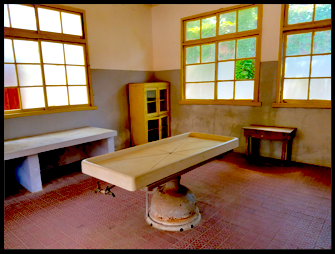Fourth Death of Hansenin
Hansenin*, or Hansen’s disease (leprosy) patients in South Korea, have historically described themselves as experiencing three deaths. The first death corresponds to their diagnosis, the second to their mandatory autopsy, and the third to their cremation and burial in a designated charnel house on Sorok Island. Although Hansen’s disease is a mildly communicable, curable bacterial skin disease, phobia around the disease has persisted in the modern era, allowing hansenin to be exploited as a showcase for imperialist notions of racial hygiene at the same time that their disease was figured as an internal enemy. In other words, Hansen’s disease has served as a useful pretext for colonizers to exert control over colonized populations, and in South Korea’s case, Japanese, U.S., and South Korean governments not only wielded total control over but also racialized hansenin along non-normative lines. In my research, I argue the weaponization of hansenin for political interests is the “fourth death” of hansenin.
Before the arrival of Christian missionaries in the 1900s, Koreans regarded hansenin as objects of pity rather than ostracization. Once missionaries built sanitariums for hansenin, the public began perceiving the disease as highly contagious. The 1910 establishment of Japanese colonial rule hastened ostracization, and from 1916 onward, the Japanese Government General of Korea quarantined hansenin in Sorok Island, a “leper colony,” mandated the sterilization of those who wished to marry, and maintained full control over their bodies after death. This imperial violence broadly viewed Koreans as “unsanitary” and requiring the medical intervention of the “hygienic” colonizer. Moreover, by spreading the misperception that Hansen’s disease is inherited genetically, the colonizer racialized hansenin as disabled bodies unfit for Korean citizenship. These ideas and practices continued during the linked eras of U.S. military rule (1945–1948) and South Korean military dictatorship. Forced sterilization and abortions continued until the 1990s.
Current hansenin advocacy led to Japan in 2006 agreeing to a reparations settlement and the South Korean government in 2017 admitting to having subjected hansenin to forced abortions and castration. Hansen’s disease is no longer seen as an ill-fated disease and only about five hundred residents (approximately ten patients are active) now live on Sorok Island. Yet the fact that most research and political advocacy has focused on the periods of Japanese colonial rule and South Korean military dictatorship means that U.S. policy on Hansen’s disease patients during the American occupation—including hate crimes committed against hansenin—and its impact remain relatively unexamined, a lacuna that further marginalizes hansenin. In particular, positive assessments of U.S. policies toward hansenin need to be reexamined. For example, the United States presented self-governance on Sorok Island as a humanitarian and democratic alternative to Japan’s quarantine policy, yet in reality this was a part of the U.S. empire-building project in Asia.
* Hansenin is a compound word that combines “Hansen” and “in” (인, 人, people) and signifies both people with and those who have recovered from Hansen’s disease in South Korea. This term can also include people who are more broadly related to Hansen’s disease such as medical staff.


